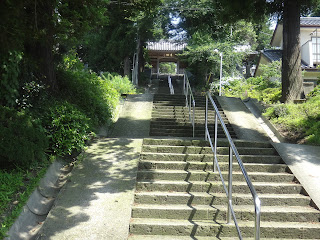A little ways down the street, I found stairs leading up to Kakuhanji, kaku means to attain enlightenment and han means pattern or extent and of course ji means Buddhist temple.
The gate at the top of the stairs was quite nice and looked fairly new, the wood had not changed color yet.
I was more than surprised to find that the guardian kings in the alcoves on either side of the opening did not have screens in front of them. It is usually difficult to get pictures of them. This is the one on the left.
And this is the one on the right. Each one is holding a weapon to fight any evil that tries to attack the temple, but I do not know why they have them in their left hands.
This is the roof of the gate. It is the traditional way of making temples and associated buildings. The carvings on the lintel represent clouds.
Just inside the gate, I found this little guy glaring at me. This probably represents Daruma, a Buddhist monk who meditated for so long that his arms and legs fell off. Daruma was from a poor family and was uneducated but because of his understanding of Zen, he became the leading priest of his time. We frequently see small (from a few inches to a few feet tall) paper mache representations of him in bright red robes. These have no eyes, so when you want something to happen, for example, you want to win an election, you paint one eye for him. If you get what you want, you paint the other eye.
Subscribe to:
Post Comments (Atom)







No comments:
Post a Comment